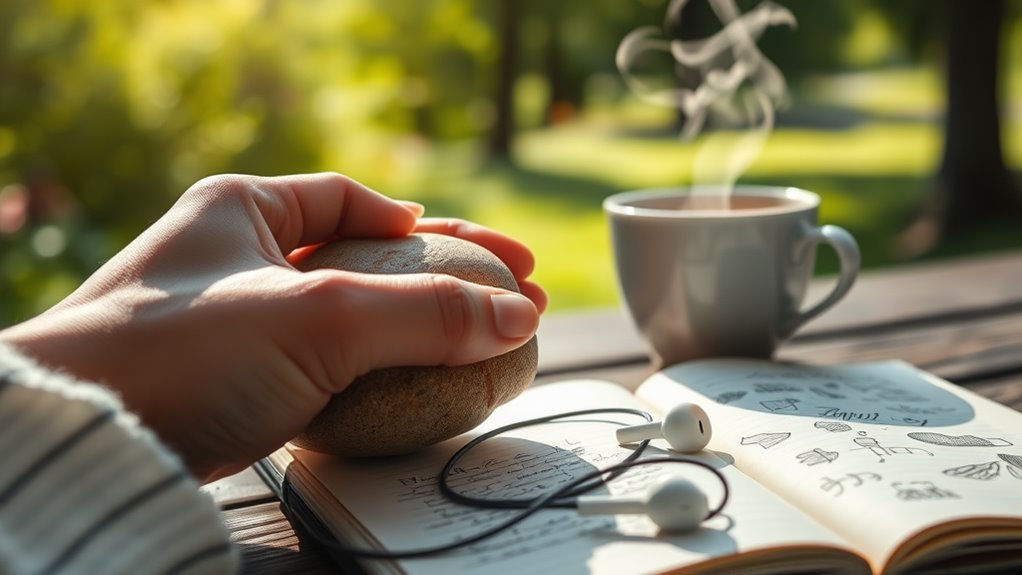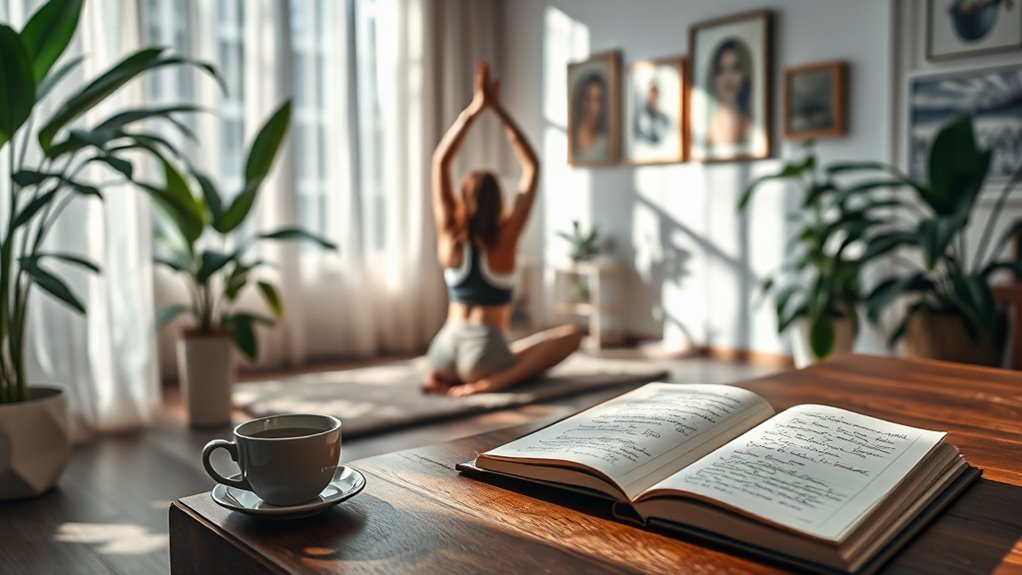Stress Relief Tips You Can Use Anytime, Anywhere
You can easily reduce stress anytime and anywhere with simple techniques that only take a few minutes. Start with deep breathing; inhale through your nose, hold, and exhale slowly to calm your mind. Practice mindfulness by taking a minute to observe your surroundings or reflect on what you’re grateful for. Quick physical activities like stretching or a brisk walk can also elevate your mood. Try visualization techniques by picturing a peaceful scene or future success. Incorporating these practices into your routine can strengthen your resilience against stress. There’s so much more you can explore to enhance your stress relief skills.
Key Takeaways
- Practice deep breathing exercises to calm your mind and slow your heart rate in any situation.
- Take a minute to engage in mindfulness, focusing on your breath and surroundings.
- Incorporate quick physical activities like stretching or jumping jacks to boost your mood instantly.
- Use visualization techniques to imagine peaceful scenes or future successes for relaxation.
- Keep a gratitude journal and note three positive things daily to enhance your well-being.
Breathing Exercises
Breathing exercises are one of the simplest yet most effective ways to relieve stress. When you feel overwhelmed, taking just a few moments to focus on your breath can make a huge difference.
Start by finding a comfortable position, whether you’re sitting or standing. Inhale deeply through your nose, allowing your abdomen to expand. Hold that breath for a few seconds, then exhale slowly through your mouth.
Repeat this process for several minutes, and you’ll notice your heart rate slowing and your mind clearing. You can try different techniques, like counting your breaths or visualizing a calm scene, to enhance the experience.
Incorporate these exercises into your daily routine, and you’ll build resilience against stress over time.
Mindful Moments
While life can often feel chaotic, taking mindful moments throughout your day can help ground you and reduce stress.
These moments allow you to reconnect with yourself and the present, making you more resilient. Here are four simple ways to incorporate mindfulness into your routine:
-
Pause and Breathe: Take a minute to focus on your breath. Inhale deeply, hold for a moment, and exhale slowly.
-
Observe Your Surroundings: Look around you and notice details—colors, sounds, and textures. Engage your senses.
-
Practice Gratitude: Reflect on three things you’re grateful for right now. This shifts your focus to the positive.
-
Engage in a Mindful Activity: Choose a daily task—like eating or walking—and do it with full attention, savoring every moment.
Embrace these mindful moments to enhance your day!
Quick Physical Activities
Incorporating quick physical activities into your day can markedly reduce stress and boost your mood. Even a few minutes of movement can make a big difference.
Try taking a brisk walk during your lunch break or doing a few jumping jacks in your living room. If you’re at work, stand up and stretch or do calf raises by your desk.
You can also opt for quick bodyweight exercises like push-ups or squats. These activities get your blood flowing and help release endorphins, your body’s natural stress relievers.
Visualization Techniques
After you’ve engaged in some quick physical activities to shake off stress, you might find it helpful to try visualization techniques.
These methods can help you focus and promote relaxation.
Here are four simple visualization techniques you can use:
-
Imagine a Peaceful Scene****: Picture yourself on a tranquil beach or a serene mountain. Feel the environment around you.
-
Color Breathing: Visualize breathing in a calming color and exhaling stress as a darker shade.
-
Future Success: Envision achieving a goal. Picture the steps you’ll take and the joy of your accomplishment.
-
Positive Affirmations: Create a mental image of yourself confidently stating affirmations. See and feel their positive impact.
Incorporating these techniques into your routine can enhance your stress relief efforts.
Gratitude Practices
Many people find that practicing gratitude can greatly enhance their overall well-being. By taking a moment each day to acknowledge what you’re thankful for, you can shift your focus from stress to positivity.
Consider keeping a gratitude journal where you jot down three things you’re grateful for each morning or evening. This simple act can boost your mood and reduce anxiety.
You can also express gratitude verbally; thank a friend or family member for their support. Even a quick text can make a difference.
Finally, try incorporating gratitude into your daily routine—pause and appreciate small moments, like a warm cup of coffee or a beautiful sunset. These practices can cultivate a more positive mindset, helping you navigate stress with ease.
Frequently Asked Questions
How Long Should I Practice Stress Relief Techniques Daily?
Practicing stress relief techniques daily can vary for you, but aim for at least 10 to 20 minutes. Consistency matters more than duration, so find what fits into your routine and stick with it.
Can Stress Relief Techniques Be Effective for Chronic Stress?
Absolutely, stress relief techniques can be effective for chronic stress. By incorporating practices like mindfulness or deep breathing into your daily routine, you can gradually reduce tension and improve your overall well-being. Don’t underestimate their power!
What Are the Best Environments for Practicing These Techniques?
The best environments for practicing stress relief techniques are quiet, comfortable spaces where you feel safe. You’ll find nature, your home, or even a cozy corner at a café can enhance your relaxation experience.
Are There Any Apps to Assist With Stress Relief Practices?
Yes, there are several apps designed to help with stress relief. You can try Calm, Headspace, or Insight Timer. They offer guided meditations, breathing exercises, and relaxation techniques that fit easily into your daily routine.
How Can I Incorporate These Techniques Into a Busy Schedule?
You can easily incorporate stress relief techniques by setting aside just five minutes during your day. Try short breathing exercises, quick stretches, or even a brief walk; it’ll refresh your mind and boost your focus.





